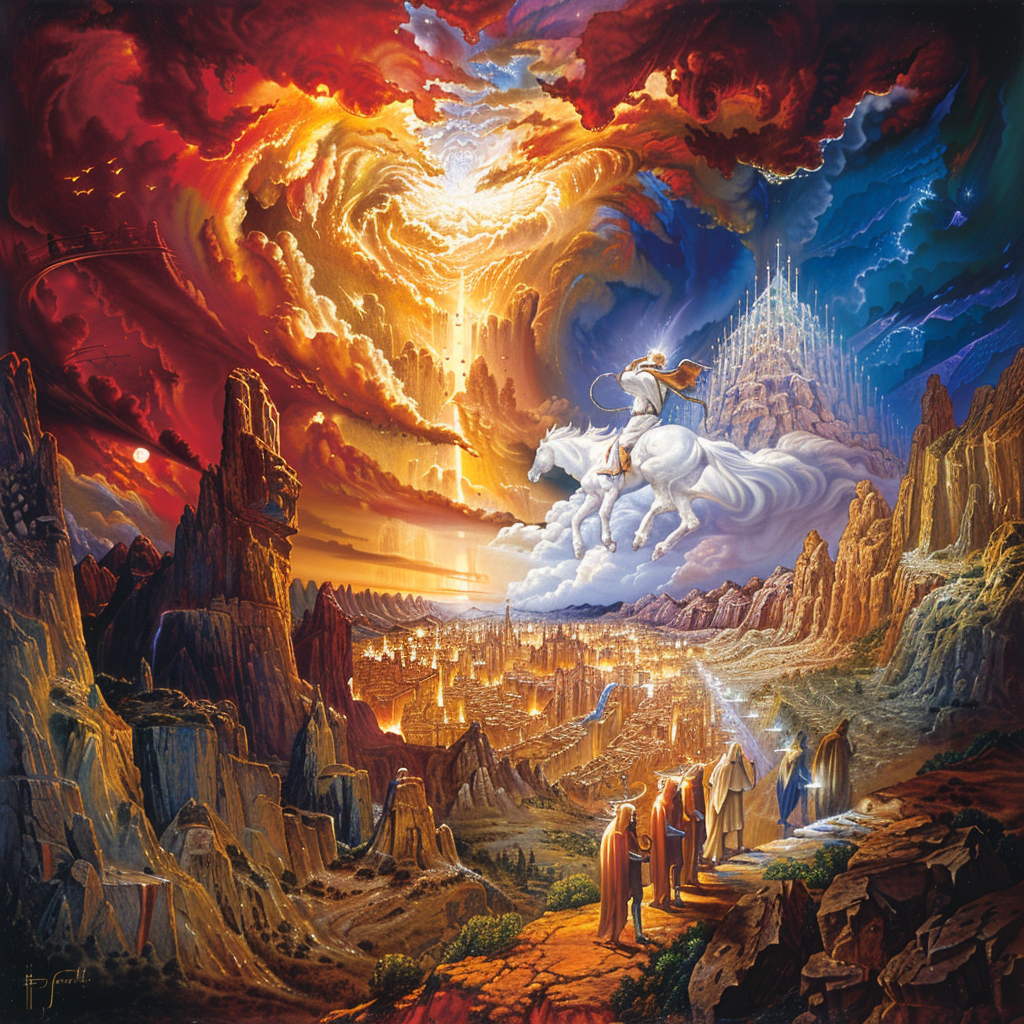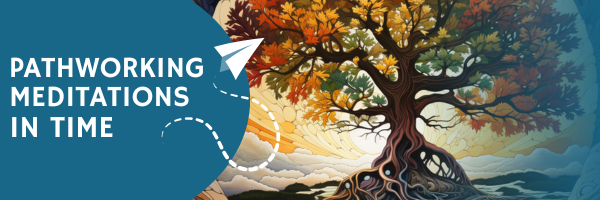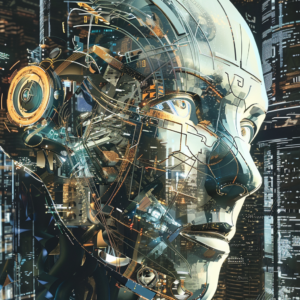
Title: The Time of Tribulation
Part 1: The Beginning of Sorrows
In the bustling city of New Haven, life went on as usual. People hurried to work, children played in parks, and the hum of modern life filled the air. However, a sense of unease was growing beneath this normalcy. Strange weather patterns, political unrest, and whispers of war created an undercurrent of fear.
One evening, a small group of believers gathered in a modest church on the city’s outskirts. Among them were John, a wise and steadfast pastor; Sarah, a dedicated nurse; David, a former soldier turned security expert; and Leah, a single mother and teacher. They had come together to study the Book of Revelation, sensing that the times were growing dire.
As they delved into the scriptures, they read of the Four Horsemen of the Apocalypse. The first horseman, on a white horse, represented conquest. The second, on a red horse, symbolized war. The third, on a black horse, stood for famine. And the fourth, on a pale horse, embodied death.
“These horsemen signify the beginning of the tribulation,” John explained. “We must be prepared for what is to come.”
That night, as they left the church, the sky darkened ominously. A powerful storm swept through the city, bringing torrential rain, hail, and fierce winds. It was unlike anything they had ever seen, a precursor of the trials.
Symbolism and Insights:
The Four Horsemen of the Apocalypse represent the onset of the end times, each horseman bringing a different form of suffering. Conquest, war, famine, and death begin the earth’s sorrows. This storm symbolizes the natural and supernatural events that will signal the start of the tribulation period.
Poem: The Beginning of Sorrows
In the city of man, shadows loom,
A storm of fate, a coming gloom.
Four horsemen ride with dread in hand,
To test the faith of every land.
Conquest’s cry and war’s fierce blaze,
Famine’s grip and death’s dark gaze.
The faithful few must stand and see,
The trials of eternity.
Part 2: The Rise of the Beast
In the weeks following the storm, the world seemed to spiral into chaos. News reports mentioned conflicts erupting in various countries, economies collapsing, and a mysterious new leader rising to power. This charismatic and influential leader promised peace and prosperity, but those who studied the prophecies recognized him as the Beast from the Book of Revelation.
John gathered the group once more. “Revelation speaks of the Beast, who will deceive many and wield great power,” he said. “We must be vigilant and not fall into his trap.”
As prophesied, the Beast would impose a mark on every person, a mark without which no one could buy or sell. Sarah, David, Leah, and John understood the gravity of this and resolved to resist at all costs. They began preparing, storing supplies, and seeking safe hiding places.
As the political landscape shifted, New Haven became a city under surveillance. Cameras were installed everywhere, and soldiers patrolled the streets. The group met secretly, sharing information and encouraging one another to stay strong in their faith.
One night, David spoke about his experience as a soldier. “I’ve seen what unchecked power can do,” he said. “This is unlike anything we’ve faced. But we must remember that our strength comes from God.”
Symbolism and Insights:
The Beast symbolizes ultimate deception and the consolidation of power. His rise is a test of faith, as believers are called to resist his influence and the mark he imposes. The mark represents allegiance to the Beast, contrasting with the seal of God on the faithful.
Poem: The Rise of the Beast
From shadows deep, a leader came,
With words of peace, he spoke his name.
But those who knew, saw through the guise,
A Beast in wait, with cunning eyes.
His mark would bind, his power ensnare,
Yet faith would be our strength and prayer.
In hidden places, whispers grew,
A remnant strong, a faithful few.
Part 3: The Tribulation Begins
The signs of tribulation grew more evident as the days turned into weeks. Earthquakes shook the ground, pestilences spread across the continents, and the sun darkened, casting an eerie gloom over New Haven. The group of believers continued to meet, finding solace in their faith and each other.
One evening, Leah shared a vision she had during prayer. “I saw seven angels with seven trumpets,” she said, trembling. “When each trumpet sounded, a new disaster struck the earth. The first brought hail and fire mixed with blood. The second turned the sea into blood. The third made the waters bitter, and many died from drinking it. The fourth darkened the sun, moon, and stars. The fifth released a plague of locusts with the sting of scorpions. The sixth unleashed four angels to kill a third of mankind, and the seventh declared God’s kingdom.”
John nodded solemnly. “The seven trumpets herald the judgments of God upon the earth. We must be prepared for these trials and hold fast to our faith.”
The group decided to strengthen their preparations. They stocked up on food and water, created emergency plans, and continued to support each other spiritually and emotionally. Each member took on specific roles: David, with his military background, focused on security; Sarah, with her medical knowledge, prepared first aid supplies; Leah taught the children and kept their spirits high; and John provided spiritual guidance.
Symbolism and Insights:
The seven trumpets symbolize God’s progressive judgments during the tribulation. Each trumpet brings a specific calamity, reflecting the severity of the end times and the need for repentance. Leah’s vision reinforces the importance of vigilance and spiritual preparedness.
Poem: The Seven Trumpets
Seven angels with trumpets high,
Heralding woes from the sky.
Hail and fire, seas of red,
Waters bitter, stars that fled.
Locusts sting, the reaper’s call,
God’s kingdom rise, the final thrall.
In trials great, our faith shall stand,
Guided by His mighty hand.
Part 4: The Mark of the Beast
The chaos continued to escalate. The Beast’s influence grew stronger, and a new decree was announced: every person must receive a mark on their right hand or forehead to buy or sell. This mark, 666, became a symbol of allegiance to the Beast.
John gathered the group in a secluded area. “Revelation 13 warns us about this mark,” he said. “We must refuse it, no matter the cost. God’s judgment will fall on those who accept it.”
The group members were resolved but knew the risks. Without the mark, they would be unable to access food, medicine, or other essentials. They would become outcasts, hunted by the authorities. Yet their faith was unwavering.
One night, Sarah was treating a sick child in the shelter when soldiers arrived, conducting searches for those without the mark. Using his military experience, David led the group through hidden tunnels beneath the city to a safe house. The soldiers, unaware of the escape routes, left empty-handed.
Leah comforted the frightened children in their new hiding place with stories of God’s deliverance. “Remember Daniel in the lion’s den and Shadrach, Meshach, and Abednego in the fiery furnace,” she said. “God protected them, and He will protect us too.”
Symbolism and Insights:
The mark of the Beast symbolizes ultimate allegiance to evil and rebellion against God. Refusing the mark represents steadfast faith and trust in God’s protection. The group’s escape mirrors the biblical stories of deliverance and divine protection.
Poem: The Mark of the Beast
In a world where darkness reigns,
A mark of power, binding chains.
Yet faith stands firm, a light in night,
Resisting evil’s blinding might.
Through trials deep, and threats that loom,
God’s faithful rise from darkest gloom.
With trust in Him, their hearts are free,
Defying death, eternally.
Part 5: The Wrath of God
The tribulations grew more intense as the group faced constant threats. Natural disasters, famine, and plague ravaged the land. Those who had taken the mark of the Beast continued to live in apparent security, while those without it suffered greatly. But John reminded everyone of Revelation 16, the chapter that spoke of the bowls of God’s wrath being poured out upon the earth.
One evening, John gathered the group to read from the Book of Revelation. “The first angel poured out his bowl, and those with the mark of the Beast were afflicted with painful sores. The second angel turned the sea to blood, and every living thing in it died. The third angel turned rivers and springs to blood. The fourth angel caused the sun to scorch people with fire. The fifth angel plunged the Beast’s kingdom into darkness. The sixth angel dried up the Euphrates, preparing the way for the kings of the East. And the seventh angel declared, ‘It is done!’ and a great earthquake shook the earth.”
As the group prayed, they witnessed some of these events. The skies turned red, and the rivers around New Haven began to run with blood. The sun’s heat became unbearable, and darkness fell over the city, shrouding it in an eerie silence. Yet, through it all, the group remained strong, their faith unshaken.
Sarah found strength in helping others and tending to the sick and wounded with her medical skills. David’s military training proved invaluable as he protected the group from marauding bands of looters and soldiers. Leah’s unwavering hope and nurturing spirit kept the children and others calm, while John’s spiritual guidance gave hope in the darkest times.
Symbolism and Insights:
The bowls of God’s wrath symbolize the final and complete judgment upon a world that has turned away from God. Each bowl represents a specific aspect of divine retribution, reflecting the severity of sin and the ultimate justice of God. The group’s faith and resilience in the face of these trials symbolize the power of belief and the protection granted to the faithful.
Poem: The Wrath of God
With bowls of wrath, the end draws near,
The earth is judged, the world must hear.
From seas of blood to scorching sun,
God’s justice reigns, His will be done.
In darkness deep and quaking land,
His faithful stand, by His command.
Through trials fierce, their hearts remain,
In God’s embrace, they feel no pain.
Part 6: The Triumph of the Lamb
The tribulations intensified, as did John, Sarah, David, and Leah’s faith. They knew the time of deliverance was near, and they clung to the promises found in Revelation. Despite the overwhelming challenges, they found solace in their prayers and each other’s company.
One night, John read from Revelation 19:11-16, describing the vision of Christ’s return. “I saw heaven standing open, and there before me was a white horse, whose rider is called Faithful and True. With justice, he judges and wages war. His eyes are like blazing fire, and on his head are many crowns. He has a name written on him that no one knows but himself. He is dressed in a robe dipped in blood, and his name is the Word of God. The armies of heaven were following him, riding on white horses and dressed in fine linen, white and clean. Coming out of his mouth is a sharp sword to strike down the nations. ‘He will rule them with an iron scepter.’ He treads the winepress of the fury of the wrath of God Almighty. He has this name written on his robe and his thigh: ” King of kings and Lord of lords.”
The group felt a renewed sense of hope and purpose. They knew that Christ belonged to the ultimate victory and that they would share in His triumph. As they continued to pray and support each other, the signs of the end times reached their climax.
One day, a great earthquake shook the city, splitting it into three parts. Mountains crumbled, and islands disappeared. The heavens opened, and a brilliant light descended upon the earth. The group fell to their knees, overwhelmed by the sight of the returning Christ and the armies of heaven.
Symbolism and Insights:
The return of Christ symbolizes the ultimate victory of good over evil, the fulfillment of God’s promises, and the establishment of His eternal kingdom. The white horse and its rider represent Christ’s purity, justice, and divine authority. The sharp sword symbolizes the power of His word to bring about judgment and redemption.
Poem: The Triumph of the Lamb
In darkest night, a light did shine,
A rider pure, of love divine.
With blazing eyes and many crowns,
He came to judge, to cast foes down.
On white steeds, the heavens came,
To praise His might, to sing His name.
King of kings, and Lord of lords,
His justice reigns, His truth restores.
Through quaking earth and skies ablaze,
His faithful rise, their voices raise.
For in His triumph, hope is found,
The Lamb of God, with glory crowned.
Conclusion: The New Heaven and New Earth
The tribulation passed, and the faithful were rewarded with a vision of the new heaven and earth. John, Sarah, David, Leah, and the others found themselves in unparalleled beauty and peace. The city of New Jerusalem descended from heaven, radiant like a bride adorned for her husband.
John read the final chapters of Revelation, describing the glory of the new creation. “And I heard a loud voice from the throne saying, ‘Look! God’s dwelling place is now among the people, and he will dwell with them. They will be his people, and God himself will be with them and be their God. He will wipe every tear from their eyes. There will be no more death or mourning or crying or pain, for the old order of things has passed away.'”
The group rejoiced, knowing that their faith had brought them through the trials and into the eternal presence of God. They sang songs of praise and gratitude, their hearts filled with love and peace.
Symbolism and Insights:
The new heaven and new earth symbolize the fulfillment of God’s promise to renew creation and establish His eternal kingdom. The New Jerusalem represents the perfect union of God and His people, free from suffering and death. The vision of the new creation reinforces the hope and assurance of eternal life for believers.
Poem: The New Heaven and New Earth
In heaven’s light, a city grand,
Descends to earth, by God’s own hand.
No tears, no pain, no death to fear,
For God Himself will dwell here.
With streets of gold and gates of pearl,
His glory shines, His love unfurls.
A new creation, pure and bright,
Eternal day, no more night.
In joy and peace, His faithful sing,
Of love divine and hope they bring.
For in His promise, life is new,
A kingdom bright, forever true.
A chart summarizing the timeline and key events in the Book of Revelation, along with the possibility of their fulfillment:
| Event | Description | Symbolism | Possibility of Fulfillment |
|---|---|---|---|
| Introduction (Revelation 1) | Vision of Christ, instruction to write down visions | Personal experience of John | Historical context shows unique to John |
| Letters to the Seven Churches (Revelation 2-3) | Messages to Ephesus, Smyrna, Pergamum, Thyatira, Sardis, Philadelphia, Laodicea | Spiritual messages to churches | Historically specific, ongoing spiritual relevance |
| The Throne in Heaven (Revelation 4-5) | Vision of God’s Throne, Lamb opening the scroll | God’s sovereignty, Christ’s redemptive work | Prophetic vision, transcends time |
| The Seven Seals (Revelation 6-8:1) | Conquest, war, famine, death, martyrs, cosmic disturbances, silence in heaven | Beginning of tribulation | Historical periods reflect these, likely future |
| The Seven Trumpets (Revelation 8:2-11:19) | Hail and fire, burning mountain, poisoned waters, darkened sun/moon/stars, plague of locusts, four angels release, kingdom of Christ | Progressive judgments, calls for repentance | No clear historical events, future fulfillment |
| The Two Witnesses (Revelation 11) | Two witnesses prophesy, are killed, and resurrected | Prophetic ministries | Symbolic figures, likely future |
| The Woman and the Dragon (Revelation 12) | The Woman (Israel/Church), The Dragon (Satan) | Spiritual warfare | Symbolic, ongoing historical context |
| The Beast and the False Prophet (Revelation 13) | Beast from the Sea (world leader), Beast from the Earth (false prophet) | Ultimate deception and power consolidation | Precursors in history, ultimate fulfillment future |
| The Lamb and the 144,000 (Revelation 14) | 144,000 sealed servants of God | Special group of believers | Possibly symbolic, future fulfillment |
| The Seven Bowls of God’s Wrath (Revelation 16) | Painful sores, sea and rivers turn to blood, scorching sun, darkness, Euphrates dries up, great earthquake | Final and complete judgment | No clear historical fulfillment, future events |
| The Fall of Babylon (Revelation 17-18) | Babylon the Great (corrupt system) falls | Corrupt systems | Historical parallels, ultimate future fulfillment |
| The Second Coming of Christ (Revelation 19) | Christ’s return, defeats the Beast and False Prophet | Ultimate victory of good over evil | Future event |
| The Millennium (Revelation 20:1-6) | 1,000-year reign of Christ, Satan bound | Period of peace and righteousness | Future event |
| Final Judgment (Revelation 20:7-15) | Satan’s final rebellion, Great White Throne Judgment | Judgment of the dead | Future event |
| New Heaven and New Earth (Revelation 21-22) | New Jerusalem, eternal state | Fulfillment of God’s promise, eternal kingdom | Future event |
This chart provides a concise overview of the events described in the Book of Revelation, their symbolism, and the potential for their fulfillment.
The Book of Revelation is rich with symbolism; understanding these symbols is key to grasping its message. Below is an explanation of some of the primary symbols found in Revelation:
1. Vision of Christ (Revelation 1)
- Symbolism:
- Seven Golden Lampstands: Represent the seven churches.
- Seven Stars: Represent the angels of the seven churches.
- Sword from His Mouth: Symbolizes the power and authority of Christ’s word.
- Eyes Like Blazing Fire: Signify Christ’s omniscience and judgment.
- Feet Like Bronze: Represent strength and stability.
- Voice Like Rushing Waters: Denotes the overwhelming authority and power of Christ’s voice.
- Interpretation: This vision emphasizes the authority, purity, and judgment of Christ, who stands among His churches, guiding and evaluating them.
2. Letters to the Seven Churches (Revelation 2-3)
- Symbolism:
- Seven Churches: Represent all Christian churches across time.
- Overcomer Promises: Each letter concludes with a promise to those who remain faithful, symbolizing eternal rewards for believers.
- Interpretation: The letters address specific issues within each church and serve as timeless messages to all Christians, encouraging faithfulness, repentance, and perseverance.
3. The Throne in Heaven (Revelation 4-5)
- Symbolism:
- Throne: Represents God’s sovereign rule.
- Twenty-four Elders: Symbolize the redeemed people of God (12 tribes of Israel + 12 apostles).
- Four Living Creatures: Represent all of creation, continuously worshipping God.
- Scroll with Seven Seals: Symbolizes the unfolding of God’s plan for history and judgment.
- Lamb with Seven Horns and Seven Eyes: Represents Christ, perfect in power and knowledge.
- Interpretation: This vision highlights God’s ultimate authority, the worship due to Him from all creation, and the central role of Christ in God’s redemptive plan.
4. The Seven Seals (Revelation 6-8:1)
- Symbolism:
- Four Horsemen: Represent conquest, war, famine, and death, signaling the beginning of God’s judgment.
- Martyrs under the Altar: Symbolize those who have died for their faith, awaiting God’s final judgment and retribution.
- Cosmic Disturbances: Represent the catastrophic events accompanying God’s judgment.
- Interpretation: The seals represent the judgment that precedes the end times, showing the effects of human sin and divine retribution.
5. The Seven Trumpets (Revelation 8:2-11:19)
- Symbolism:
- Trumpets: Signify divine warnings and judgments.
- First Four Trumpets: Bring natural calamities affecting the earth, sea, freshwater, and sky.
- Fifth and Sixth Trumpets: Unleash demonic forces and armies.
- Seventh Trumpet: Declares the establishment of God’s kingdom.
- Interpretation: The trumpets serve as escalating judgments, warning humanity to repent before the final judgment.
6. The Two Witnesses (Revelation 11)
- Symbolism:
- Two Witnesses: Represent the church’s prophetic witness and testimony.
- Three and a Half Years: Symbolize a period of persecution and suffering.
- Death and Resurrection: Echo Christ’s death and resurrection, signifying ultimate victory.
- Interpretation: The witnesses represent God’s faithful people who testify to His truth, suffer for their witness, but are ultimately vindicated.
7. The Woman and the Dragon (Revelation 12)
- Symbolism:
- Woman: Represents Israel or the church.
- Dragon: Represents Satan.
- Child: Represents Christ.
- Interpretation: This vision symbolizes the cosmic battle between good and evil, the birth of Christ, and the persecution of God’s people by Satan.
8. The Beast and the False Prophet (Revelation 13)
- Symbolism:
- Beast from the Sea: Symbolizes a powerful, anti-Christian political leader.
- Beast from the Earth (False Prophet): Represents a deceptive religious leader promoting the worship of the first beast.
- Mark of the Beast: Symbolizes allegiance to the Beast and rejection of God.
- Interpretation: The beasts symbolize the ultimate manifestation of evil political and religious power, challenging God’s authority.
9. The Seven Bowls of God’s Wrath (Revelation 16)
- Symbolism:
- Bowls: Represent complete and final judgments.
- First Six Bowls: Bring various plagues upon those who follow the Beast.
- Seventh Bowl: Completes God’s wrath with a final, catastrophic judgment.
- Interpretation: The bowls represent the culmination of God’s wrath against sin, leading to the final judgment.
10. The Fall of Babylon (Revelation 17-18)
- Symbolism:
- Babylon the Great: Symbolizes a corrupt, anti-God system or city.
- Prostitute: Represents false religion or corrupt society.
- Interpretation: Babylon’s fall signifies the ultimate destruction of all systems opposed to God, emphasizing the triumph of God’s righteousness.
11. The Second Coming of Christ (Revelation 19)
- Symbolism:
- Rider on the White Horse: Represents Christ returning in glory.
- Armies of Heaven: Symbolize the saints and angels accompanying Christ.
- Interpretation: Christ’s return signifies the final defeat of evil and the establishment of His eternal reign.
12. The Millennium (Revelation 20:1-6)
- Symbolism:
- 1,000-Year Reign: This represents peace and righteousness with Christ ruling.
- Binding of Satan: Signifies the temporary restraint of evil.
- Interpretation: The Millennium represents a time of peace and justice under Christ’s rule, preceding the final judgment.
13. Final Judgment (Revelation 20:7-15)
- Symbolism:
- Great White Throne: Represents God’s ultimate authority in judgment.
- Book of Life: Symbolizes the record of those saved by faith in Christ.
- Interpretation: The final judgment determines the eternal destiny of every person, emphasizing the need for faith in Christ.
14. New Heaven and New Earth (Revelation 21-22)
- Symbolism:
- New Jerusalem Represents God’s perfect, eternal dwelling place with His people.
- River of Life and Tree of Life: Symbolize eternal life and healing.
- Interpretation: The new creation represents the fulfillment of God’s redemptive plan, where believers will dwell with Him forever in perfect peace and joy.
Conclusion:
The Book of Revelation uses vivid symbolism to convey profound spiritual truths about the end times, God’s ultimate victory over evil, and the establishment of His eternal kingdom. While some symbols have historical parallels, the full realization of these events is anticipated. The message of Revelation calls believers to remain faithful, find hope in God’s promises, and expect the glorious fulfillment of His plan.
Conclusion: Understanding Revelation and the Time of Sorrows
The Book of Revelation is a profound and complex narrative that provides a glimpse into the future events of the end times, highlighting God’s ultimate triumph over evil, the final judgment, and the establishment of a new heaven and a new earth. Through its vivid and symbolic language, Revelation calls believers to remain faithful and hopeful, trusting in God’s sovereign plan and fulfilling His promises.
Entering the Time of Sorrows:
As we examine the world today, it is not difficult to see parallels with the early stages of the events described in Revelation. Jesus spoke of the “beginning of sorrows” in Matthew 24:8, referring to a period of turmoil and tribulation leading up to the end times. Several signs suggest that we may be entering this prophesied period:
1. Increased Natural Disasters:
- Observation: The frequency and intensity of natural disasters such as earthquakes, hurricanes, wildfires, and floods are rising.
- Symbolism in Revelation: These events could be precursors to the more catastrophic judgments described in the seals, trumpets, and bowls.
2. Global Unrest and Conflict:
- Observation: Political instability, wars, and civil unrest are escalating worldwide.
- Symbolism in Revelation: This imagery aligns with that of the Four Horsemen, particularly the red horse representing war and the black horse symbolizing economic instability and famine.
3. Moral and Spiritual Decline:
- Observation: There is a noticeable decline in moral values, increased persecution of Christians, and a rise in false teachings and religions.
- Symbolism in Revelation: This corresponds with the warnings to the seven churches and the rise of the Beast and the False Prophet, which represent ultimate deception and moral corruption.
4. Technological Advancements:
- Observation: Rapid technological advancements, including AI, digital currency, and surveillance, could facilitate the global control described in Revelation, particularly implementing the mark of the Beast.
- Symbolism in Revelation: The ability to enforce the mark on every person suggests a level of technological control that is becoming increasingly plausible.
5. Plagues and Plandemics:
- Observation: The recent global pandemic and the potential for future outbreaks highlight our vulnerability to widespread disease.
- Symbolism in Revelation: The plagues described in the trumpets and bowls mirror the current reality of pandemics, which cause widespread fear and devastation.
A Call to Faith and Vigilance:
The signs of the times urge us to remain vigilant and grounded in our faith. Revelation’s message is ultimately one of hope and encouragement for believers. Despite the trials and tribulations, God’s sovereignty and the promise of Christ’s return offer assurance and peace.
Practical Steps for Believers:
- Strengthen Faith: Deepen your relationship with God through prayer, Bible study, and fellowship with other believers.
- Stay Informed: Be aware of global events and understand their potential significance in light of biblical prophecy.
- Live Righteously: Reflect Christ’s love and righteousness in your daily life, serving as a beacon of hope to others.
- Share the Gospel: Use this time to share the message of salvation with those around you, emphasizing the urgency of turning to Christ.
- Prepare Spiritually and Practically: Be prepared for potential hardships by cultivating resilience, building community support, and trusting God’s provision.
Conclusion:
The Book of Revelation provides a prophetic roadmap to the end times, filled with symbolic imagery that calls for interpretation and understanding. As we observe the current state of the world, there are clear indications that we may be entering the “time of sorrows.” These signs compel us to remain steadfast in our faith, vigilant in our watchfulness, and active in our witness. Through it all, we can find hope in the promise of Christ’s return and the ultimate establishment of His eternal kingdom. As believers, let us hold fast to the assurance that, despite the trials ahead, God’s love, grace, and sovereignty will prevail, leading us to a future filled with eternal peace and joy.
No tags for this post.



